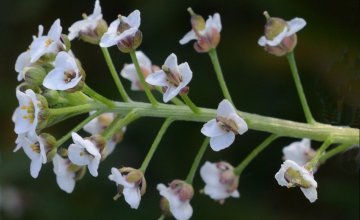Collaborations: tropism
Sandi Ratliff, Senior December 13, 1999
Texas Woman’s University
Denton, Texas
PLANT TROPISM
In order to survive, living organisms must regulate their activities according to their environment and must be capable of adapting to different situations. While animals utilize their five senses; touch, see, smell, hear, and taste, plants make use of their own type of sensations. Plants use nastic movements and tropisms as adaptive mechanisms to change their growth in ways that help them adjust to their environment.
Plant movements that are independent of the direction of the stimulus or that are caused by non-directional stimuli are called nastic movements, or nasties. Sleep or nyctinastic movements are probably the most common. They respond to light and darkness by causing leaves to move up and down. The leaves are positioned horizontally during daylight for the purpose of capturing as much sun energy as possible for photosynthesis and vertically at night for “sleep”. This response results from turgor pressure changes in cells on the upper and lower surfaces of the pulvinus. Nastic movements resulting from touch, shaking, and electrical or thermal stimulation are called thigmonastic movements. This response is also due to change in turgor pressure. Only a single leaflet needs to be stimulated in order for the response to occur. Thigmonasty can be observed with the leaves of the sensitive plant, Mimosa pudica, and the Venus flytrap.
Plants are also able to react to certain forms of stimulation by moving specific parts or by growing. This response is called a tropism. A tropism is defined as a growth response involving bending, or curving of a plant part toward or away from an external stimulus that determines the direction of movement. A response toward the stimulus is said to be positive and response away from the stimulus is negative. Tropisms are classified according to the nature of the stimulus.
One type of tropism, phototropism, is a response to light. Most leaves indicate this by curving around to grow toward the light. This growth response is caused by elongation of the cells that are on the shaded side of the plant. The hormone auxin influences elongation and is responsible for the phototrophic curvature. Heliotropism or solar tracking is another type of response to sunlight. This gives the leaves and flowers of many plants the ability to orient themselves either perpendicular or parallel to the sun’s direct rays. In one kind of heliotropism, diaheliotropism, the leaf blades orient perpendicularly to the sun’s rays and these leaves appear to have high photosynthetic rates. In the other kind of heliotropism, paraheliotropism, plants avoid direct sunlight by orienting their leaf blades parallel to the sun’s rays, which enhances survival during periods of drought.
Gravitropism is the response of a shoot or a root to gravity. This can be observed with a seedling that is placed on its side: its root will grow downward, and its shoot will grow upward, bending at 90 degrees. Growth of root is called positive gravitropism and the growth of shoot is called negative gravitropism. The redistribution of auxin to the lower side of a shoot or root may be an explanation of the upward curvature of the shoot and the downward curvature of the root.
Another type of tropism, called hydrotropism, is a response to water. Hydrotropism can be seen in some roots that respond to differences in soil moisture content by growing toward regions of greater water potential. Sensor cells for the presence of water are found in the root cap and studies indicated that calcium plays a role in the induction of root hydrotropism.
One final tropism that should be mentioned is the response to touch or thigmotropism, which is most readily seen in the tendrils of climbing vines or pea seedling leaves. The tendrils are stimulated to grow in the direction of physical contact with a solid object, and they tend to wrap around whatever structure they contact. This response assists the plant in obtaining the necessary support for growing upwards, toward the beneficial sun light.
Tropisms differ from nastic movements in being influenced by the direction of the stimulus. Tropisms are directional growths of a plant part in response to an external stimulus. Nastic movements, however, are those that occur in response to a stimulus but whose direction is independent of the direction of the stimulus. Plants utilize both of these mechanisms in order to respond and make adjustments to changes in their environment. These mechanisms have played a major role in the success of plants in our world today.
General Reference
“Biology of Plants” by Peter Raven, Ray Evert, and Susan Eichhorn, 1999 Edition








